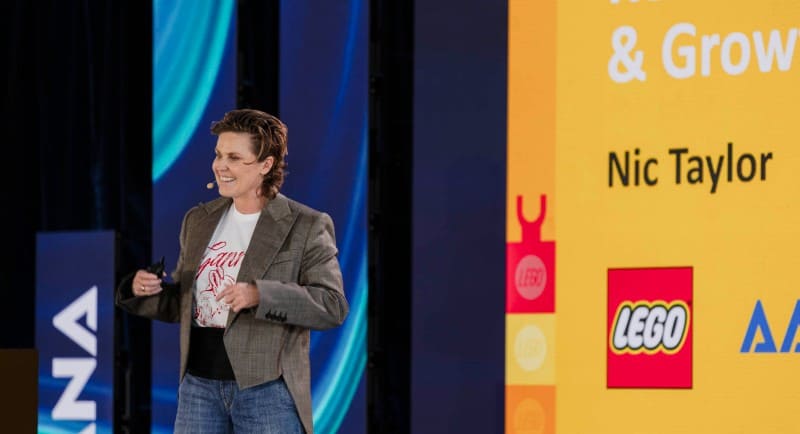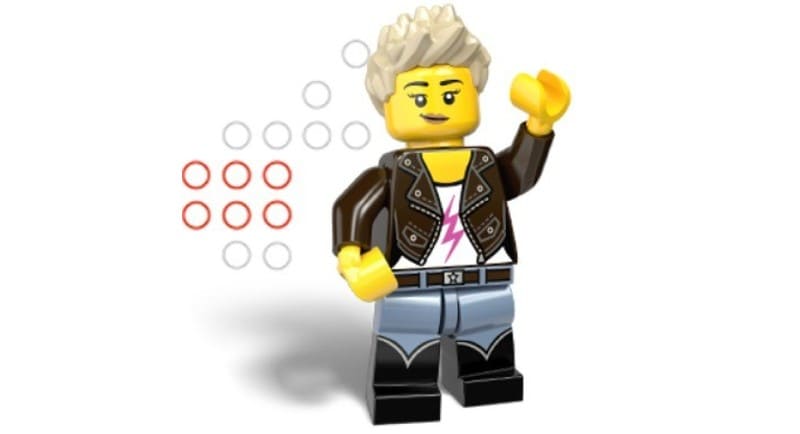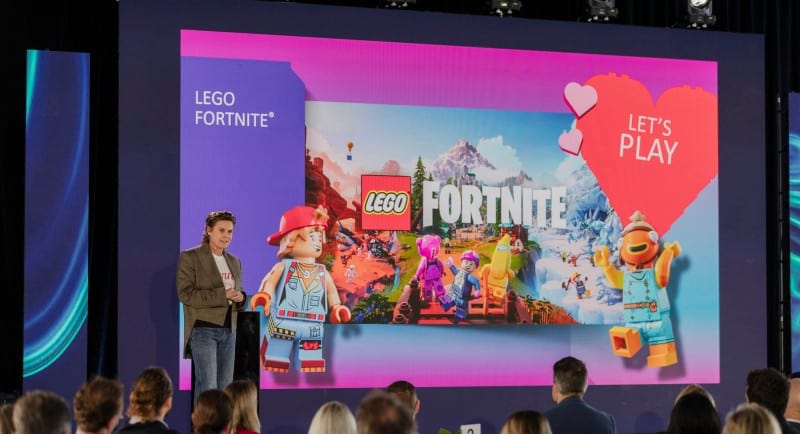“We are literally people’s imaginations,” LEGO Group’s Nic Taylor told the audience at yesterday’s AANA RESET conference.
The senior vice president spoke to the creativity, relevance, and growth that has defined the LEGO Group for 92 years. One of the world’s most loved brands continues to iterate, though, bringing joy and inspiring play through the its iconic brick.
Now based in Denmark, Taylor is a familiar face locally, most notably for her time at DDB, including her stretch as CEO at DDB Sydney. Prior to LEGO, Taylor was CEO at 14 (or Catorce), a global creative agency powered by the Omnicom-owned agency, headquartered in Barcelona.

Speaking to Mediaweek, Taylor says her time down under working on brands like Volkswagen and McDonald’s at DDB, “made me better at the job of doing global work.”
“It set me up for being able to do something like this, I think, in a way that I understood.
“When I went into the LEGO company, I thought, I already know so much.
“The truth is, I’ve had to learn whole new ways of working, whole new ways of communicating to kids.”
One of the most impactful forces for the LEGO brand is the power of fandom.
Citing examples such as Taylor Swift and Beyoncé, she explained “fandom is not influencers. It is not just the simple process of finding people who can talk positively about your brand and giving them a bit of money, and seeing what happens.
“This is recognising that there’s some people who buy your product, and are deeply, deeply committed to that product.”
That commitment is not by chance. The brand’s spirit is “only the best is good enough,” continuing the philosophy of LEGO’s original founder, toy maker Ole Kirk Kristiansen.
“I think craft is a thing that is sometimes lost, in the rush to be agile,” she explained, setting the scene in 1932 with the seminal story of Kristiansen’s toy duck, which Taylor said she learned about as part of the LEGO Group’s onboarding process.
“A point of difference was that he painted this duck three times. Not twice, three times. He was so about the quality… It was the second generation, his son, thought he was being innovative and entrepreneurial. He decided that two coats would do it. He’s like, ‘there’s no need for this third coat.’
“The old man found out, and by then these products were already shipped to the local people [and] it was hand-delivered, it wasn’t like those big truck deliveries on their behalf. His dad said to go back and get them all, and put that third coat of paint on.
“That is a true story, and that philosophy of quality and craft exists in every choice we make, there is no cutting corners.”
She continued: “We sometimes forget the power of craft and what it can mean to the end user: this beautiful thing, that endures.” Consider the intergenerational LEGO brick bin in many households.
An enduring product works. LEGO grew its revenue by 2% in 2023, a year in which the toy category was in decline.
“We gained market share in a really tough year,” said Taylor, who attributes the category success to “all the choices that come from a really clear purpose.”
See also: TV Report 7 May 2024: LEGO Masters finale sees biggest build in show’s history
Of course, much goes into marketing LEGO, even as Taylor admitted, “it is hard to get marketing right today. It is hard, it is complex. You can’t do everything every time – it doesn’t make sense.”
Even for LEGO: “We don’t have the people or the money [to invest in everything], and we’re pretty well resourced.”
While recognising the challenges of the marketing landscape, Taylor said brands must take risks and embrace failure, which she said is easier for LEGO thanks to its in-house agency.
“It [in-housing] doesn’t have to be a compromise if you put the right processes and inspiration in place,” she said.
For example, while she declared the VIDIYO AR product as “a flop for us,” she described using “all the learnings to feed the next iteration.”
“It’s not wasted effort. It’s not wasted time. As long as you recognise it as a learning opportunity.”

LEGO also came to realise that girls were an audience the brand was accidentally undeserving through limiting language like ‘building’ and ‘construction’.
“The brick doesn’t have a bias,” she said, so its marketing should be inclusive. The key take away, Taylor said, is to “think about new audiences that you’re under serving– should you invest in them?”
LEGO also realised the adult market was an untapped segment, which Taylor says has become really significant to the brand recently.
“The ‘grown up kids’, they’re huge for us now. We’re just noticing that certain adults are buying our products. And we took notice,” she explained, saying that the growth has mostly been organic among AFOL – adult fans of LEGO.
“So then what happens if we create a whole portfolio dedicated to adults? … People are prepared to pay for these beautiful experiences.”
See also: Brick by Brick: How Lego is targeting adult audiences to grow the brand
However, “there’s no silver bullet,” Taylor said.
“It’s just a series of choices, very strategic choices that are made, not least of which we invest a lot in brand.”
She told Mediaweek that business growth means more than one thing. “There’s audience growth, there’s brand growth, which I think is a good indicator of whether you’re doing a good job or not.”
She also referenced real world impact. “In our case, you know, we are genuinely delivering on supporting the builders of tomorrow,” citing LEGO’s recently successful lobby for the United Nations to create an International Play Day.
It’s a far cry from 2003, when the business was “close to failing properly.”
“In a way, they had diversified and done so many things that they kind of lost their way … they had a choice, many people were saying to sell the company.”
Instead, the company, which is still in its third generation of family ownership, decided instead to back itself, and returned to basics.
Its expansion since has included the LEGO movies, a recent collaboration with Fortnite, and an upcoming movie with pop star Pharrell.
Taylor credited her peer, Jill Lin, head of interaction design, saying, “she looks for what partnerships make sense for us that keep us cool and relevant, and at the cutting edge of culture, and then we make sure that that’s a good arrangement for both of us to be commercially successful.”
In terms of local partnerships, Taylor said LEGO Masters is the “best ad campaign ever made.” Just this week, the LEGO Masters finale on Nine saw the biggest build in its history.
During her keynote, she also mentioned that, “in a world where creativity is democratised, think about how you might be allowing your fans to participate in the creation of the product.”
While LEGO and Fortnite are two brands that wouldn’t naturally go together, the partnership was executed thoughtfully. Taylor noted it takes longer to do things in a way that aligns with brand purpose. The game was gated so the experience was safe – Taylor said the brand had steered clear from gaming for a while because it has a reputation of not being safe or healthy for kids, and kids are LEGO’s “role models”.
“Fortnite works in days, we work in years,” she explained, referencing the “culture clash.”
“Now we have beautiful world we get data from, a whole new audience we can introduce to physical world of bricks.”
LEGO’s retail stores draw significant foot traffic, with the opening of biggest store yet in Sydney’s Pitt Street just last year. Taylor said D2C is still a massive driver of growth for LEGO. “The stores work like advertising,” she said. “It contributes to brand experience and halo.”
“We’re forever innovating,” she added to Mediaweek.
“But we’re doing it in a really considerate way, with kids at the heart, and really thinking about what’s good for the long term, not just the short term, and we make those investments. They’re real investments.”
–
Top Image: Nic Taylor
